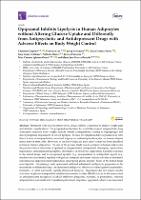Por favor, use este identificador para citar o enlazar este ítem:
https://repositorio.usj.es/handle/123456789/379
| Título : | Opipramol inhibits lipolysis in human adipocytes without altering glucose uptake and differently from antipsychotic and antidepressant drugs with adverse effects on body weight control |
| Autor: | Carpéné, Christian


Les, Francisco 


Mercader, Josep 

Gómez-Zorita, Saioa 

Grolleau, Jean Louis 
Boulet, Nathalie 

Fontaine, Jessica 
Iglesias-Osma, Maria Carmen 


Garcia-Barrado, Maria José G. 


|
| Palabras clave : | Tejido adiposo; Obesidad; Monoamina oxidasa; Amina oxidasa sensible a semicarbazida; Transporte de glucosa; Lipotoxicidad; Insulina; Antidepresivo antipsicótico harmina fenelzina; Opipramol |
| Fecha de publicación: | 5-mar-2020 |
| Editorial : | MDPI AG |
| Citación : | Carpéné, C., Les, F., Mercader, J., Gomez‐zorita, S., Grolleau, J. -., Boulet, N., . . . Garcia‐barrado, M. J. (2020). Opipramol inhibits lipolysis in human adipocytes without altering glucose uptake and differently from antipsychotic and antidepressant drugs with adverse effects on body weight control. Pharmaceuticals, 13(3) doi:10.3390/ph13030041 |
| Descripción : | Treatment with several antipsychotic drugs exhibits a tendency to induce weight gainand diabetic complications. The proposed mechanisms by which the atypical antipsychotic drugolanzapine increases body weight include central dysregulations leading to hyperphagia anddirect peripheral impairment of fat cell lipolysis. Several investigations have reproducedin vitrodirect actions of antipsychotics on rodent adipocytes, cultured preadipocytes, or human adiposetissue-derived stem cells. However, to our knowledge, no such direct action has been describedin human mature adipocytes. The aim of the present study was to compare in human adipocytesthe putative direct alterations of lipolysis by antipsychotics (haloperidol, olanzapine, ziprazidone,risperidone), antidepressants (pargyline, phenelzine), or anxiolytics (opipramol). Lipolytic responsesto the tested drugs, and to recognized lipolytic (e.g., isoprenaline) or antilipolytic agents (e.g.,insulin) were determined, together with glucose transport and amine oxidase activities in abdominalsubcutaneous adipocytes from individuals undergoing plastic surgery. None of the tested drugswere lipolytic. Surprisingly, only opipramol exhibited substantial antilipolytic properties in themicromolar to millimolar range. An opipramol antilipolytic effect was evident against isoprenaline-,forskolin-, or atrial natriuretic peptide-stimulated lipolysis. Opipramol did not impair insulinactivation of glucose transport but inhibited monoamine oxidase (MAO) activity to the same extentas antidepressants recognized as MAO inhibitors (pargyline, harmine, or phenelzine), whereasantipsychotics were inefficient. Considering its unique properties, opipramol, which is not associated with weight gain in treated patients, is a good candidate for drug repurposing because it limitsexaggerated lipolysis, prevents hydrogen peroxide release by amine oxidases in adipocytes, and isthereby of potential use to limit lipotoxicity and oxidative stress, two deleterious complications ofdiabetes and obesity. |
| URI : | https://repositorio.usj.es/handle/123456789/379 |
| ISSN : | 1424-8247 |
| Aparece en las colecciones: | Artículos de revistas |
Ficheros en este ítem:
| Fichero | Descripción | Tamaño | Formato | |
|---|---|---|---|---|
| Opipramol inhibits lipolysis in human adipocytes without altering glucose uptake and differently from antipsychotic and antidepressant drugs with adverse effects on body weight control.pdf | 2,05 MB | Adobe PDF |  Visualizar/Abrir |
Este ítem está sujeto a una licencia Creative Commons Licencia Creative Commons

